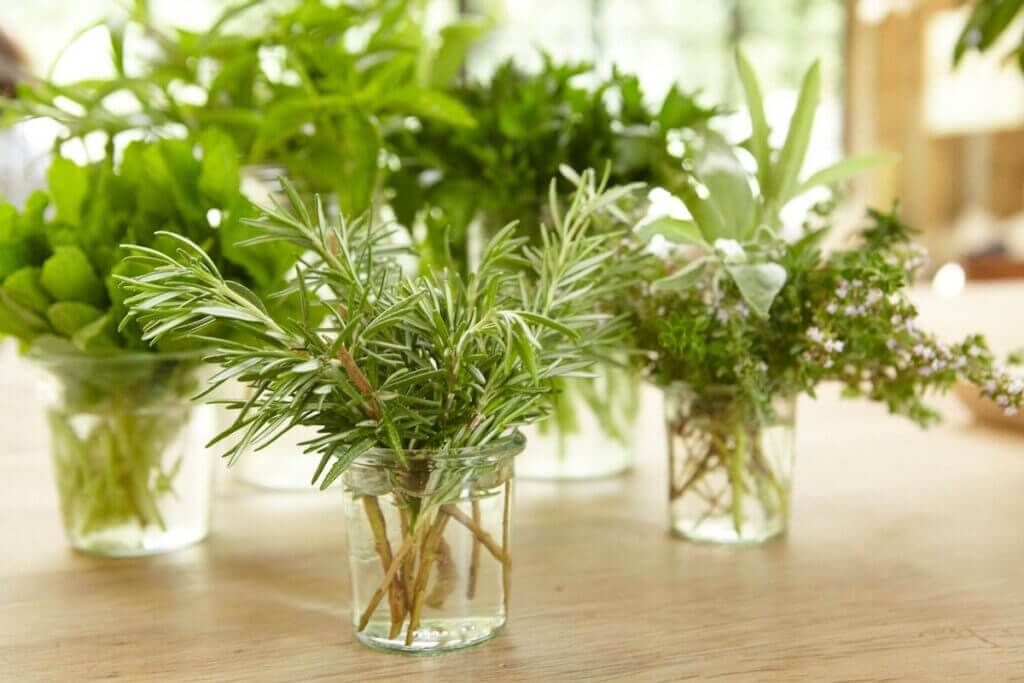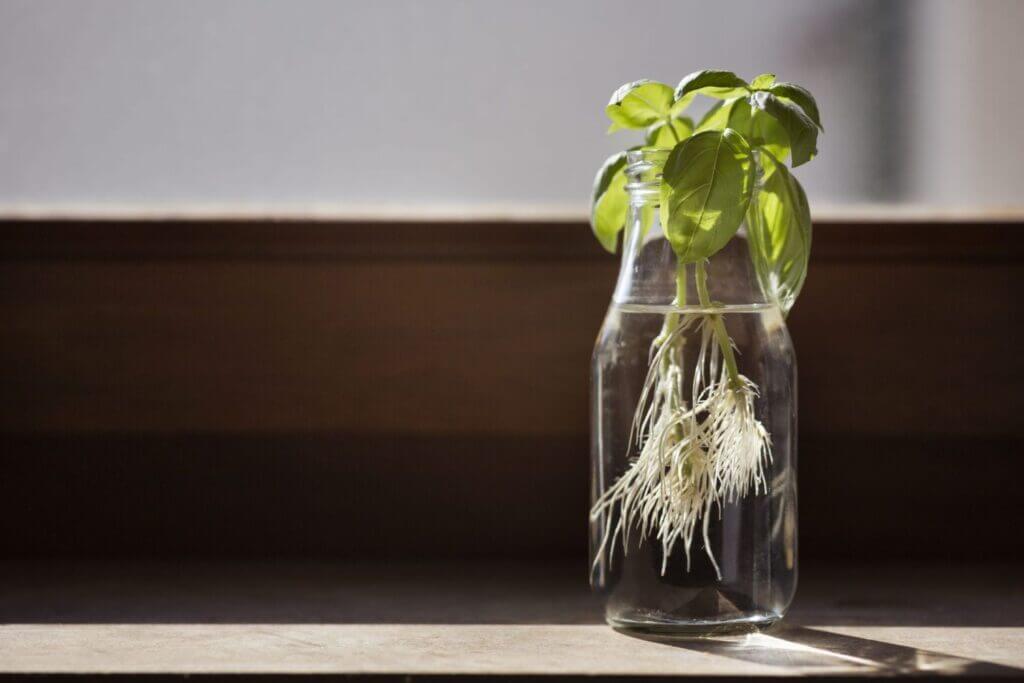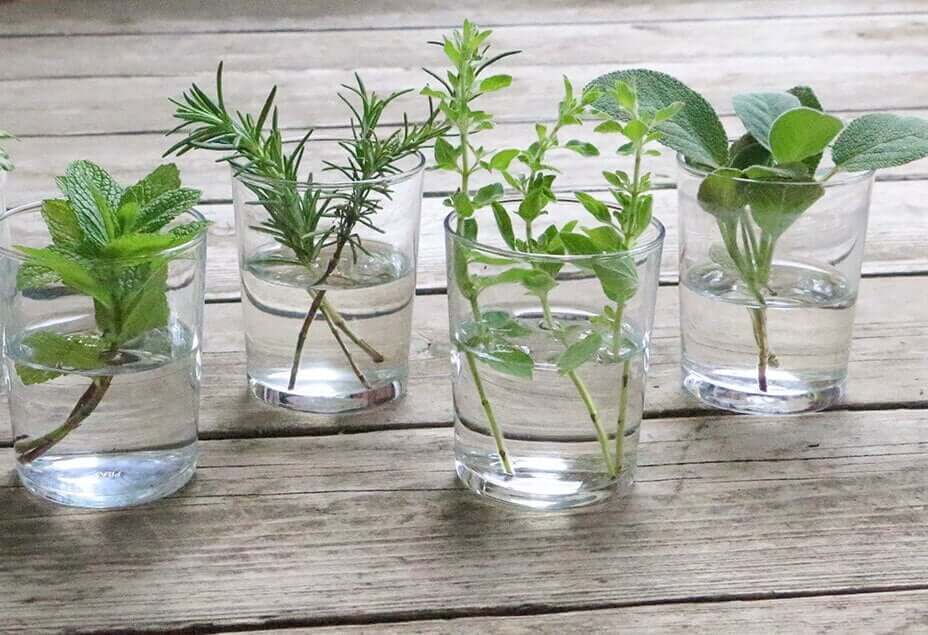Growing Herbs in Water
Water isn’t just for drinking – it’s a luxurious spa for your herbs! Welcome to the world of water-based herb gardening, where the soil takes a backseat. Imagine fresh herbs at your fingertips, flourishing in nothing but H2O! This method is not only incredibly easy but also a fantastic space-saver, making it perfect for the urban gardener or anyone looking to add a splash of green to their home or kitchen windowsil.
Advantages of Water-Based Herb Gardens
Why soil when you can water? Growing herbs in water is like giving them a perpetual bath. It’s cleaner, easier, and surprisingly less fussy. No more soil spillage or guessing games with watering. Plus, it’s a boon for those living in apartments or homes with limited gardening space. Imagine your kitchen window sill lined with jars of lush, green herbs, ready to make your next meal a gourmet affair!
Essentials for Starting Your Water Herb Garden
Begin your water gardening journey with a simple checklist: clear glass jars, water, and a sunny spot. That’s it – you’re almost a gardener now! Cuttings from your favorite herbs are the starting point. Just make sure the leaves don’t get wet; we’re giving them a drink, not a bath. And remember, patience is key – roots might take time to appear, but it’s worth the wait!
The Best herbs to grow in water
1. Grow Mint in Water
Mint is extremely robust and can grow from just about any cutting. For best results, take a 10-15 cm cutting just below a node (where a leaf grows) from a healthy mint plant. Remove the lower leaves and place the stem in a container filled with water, ensuring that no leaves are submerged. Place the container in a bright area with indirect sunlight. Roots should appear within a week. Mint can become leggy, so regular harvesting and pruning will help maintain a bushy, productive plant.
2. Grow Basil in Water
Basil requires a little more warmth, so ensure it’s placed where it can receive plenty of sunlight. Similar to mint, take cuttings of about 10-15 cm in length, strip the lower leaves, and immerse the stems in water. Basil roots will grow quickly, usually within 5 to 10 days. Change the water frequently to keep it clear and fresh. Basil is sensitive to cold, so keep it away from drafts.
3. Grow Lemon Balm in Water
This herb prefers indirect light and cooler conditions than basil. Take a cutting in the same manner as mint and basil, and place it in water. It may take a little longer to root, so patience is key. Once rooted, lemon balm can grow quite vigorously. Keep it trimmed to encourage a bushier plant and prevent it from becoming too leggy.
4. Grow Oregano in Water
Oregano cuttings should be taken from the soft, new growth of an established plant. Once the cuttings are placed in water, they will root in a couple of weeks. Oregano likes a mix of sun and shade throughout the day. Too much direct sunlight can harm the tender roots, so a sunny windowsill that receives some afternoon shade is ideal.
5. Grow Chives in Water
Chive cuttings root easily in water. The cuttings should include the base of the plant where the roots were. Place the bulb end in water, and new green shoots should start appearing in about a week. Chives grown in water will need a good amount of sunlight but should be protected from the hottest rays.
6. Grow Coriander in Water
Coriander can be a bit trickier to root in water. Use cuttings from new growth and change the water every couple of days to keep it fresh. It will root best in a cooler, partially shaded location, avoiding the intense midday sun.
7. Grow Parsley in Water
Parsley cuttings take the longest to root, sometimes up to three weeks. They need plenty of indirect sunlight. Once rooted, parsley requires less light than many other herbs, so it’s perfect for those lower-light areas of the home.
Growing Herbs Like Sage, Thyme, and Rosemary in Water
Woodier herbs like sage, thyme, and rosemary can be grown in water but typically these are unlikely to grow to the point where you can reliably harvest them. So though these herbs can be rooted and grown indoors we suggest you plant them outdoors once they are ready to grow a little larger.

How to Grow Herbs in Water
Propagating Herbs in Water: Snip, submerge, and smile! Propagating herbs in water is as easy as snipping a few stems from your favorite herb, removing the lower leaves, and placing them in water. Make sure they get plenty of indirect sunlight. In a few weeks, you’ll see tiny roots waving at you. That’s your green signal to celebrate!
How to Feed and Fertilise Herbs Growing in Water
To feed herbs growing in water, you should provide them with nutrients that they would typically get from soil. Here’s how you can do it:
-
Hydroponic Nutrients: Use a balanced, water-soluble fertilizer made for hydroponic systems. These nutrients are specifically designed to dissolve completely in water and provide all the necessary nutrients that plants need.
-
Liquid Plant Food: If hydroponic solutions are not available, you can also use a general-purpose liquid plant food. Be sure to dilute it to a quarter of the strength recommended for soil-grown plants to avoid over-fertilizing.
-
Change the Water Regularly: Refresh the water weekly to provide a clean environment and prevent the build-up of harmful pathogens. When you change the water, reapply the nutrients to ensure a consistent supply.
-
Monitor pH Levels: The pH of the water can affect the herb’s ability to absorb nutrients. The ideal pH for most herbs is slightly acidic to neutral, around 5.5 to 6.5. You can use pH testing kits to monitor and adjust the pH if necessary.
-
Use Room Temperature Water: Cold water can shock the roots, while water that’s too warm can promote the growth of algae and bacteria. Use room temperature water when changing the nutrient solution.
Remember, over-fertilizing can be just as detrimental as not fertilizing at all. It’s important to follow the instructions on your nutrient solution and observe your plants for any signs of nutrient deficiency or toxicity, adjusting as needed.
Caring for Your Water Herb Garden
Herb parenting 101: Change the water every few days to keep it fresh and algae-free. Your water-grown herbs love sunbathing, so ensure they get their dose of indirect sunlight. No need for a green thumb – just a regular check-up and some TLC. A spray of liqiud fertiliser every few weeks is a good idea, but remember not to harvest after you apply this.
Overcoming Challenges in Water Herb Gardening
Algae invasion? Root rot? Fear not! Keep algae at bay by using opaque jars or changing water regularly. If roots start looking unhappy, give them a fresh start with a water change. Remember, every challenge is an opportunity to become a better herb whisperer.
Grow Herbs In Water Q&A
Frequintly asked quetions about water herb gardening
Will herbs grow in just water?
Yes, many herbs can grow in just water through a process called hydroponic gardening. Soft-stemmed herbs like basil, mint, and cilantro root well and can thrive in water without soil. However, woodier herbs like rosemary may root in water but are better suited to planting in soil for long-term growth.
How do you keep herbs alive in water?
To keep herbs alive in water, use a clean container and change the water regularly, at least once a week. Ensure the cuttings receive sufficient indirect sunlight and use room temperature, non-chlorinated water. For nutrients, consider adding hydroponic fertilizer to the water according to the product’s instructions.
Can rosemary grow in water alone?
Rosemary can start its growth in water alone by rooting cuttings, but for it to grow larger and be harvestable, it’s recommended to transplant it to soil after roots have established.
Will basil grow in water?
Basil grows very well in water and can be continually harvested. Just make sure it has enough warmth and sunlight, and regularly change the water to prevent bacterial growth.
How long does rosemary take to root in water?
Rosemary can take several weeks to root in water, often between 2 to 8 weeks. It roots more slowly than softer-stemmed herbs and requires patience and good care.
How long do herbs last in water?
Herbs can last indefinitely in water if their needs are met. Soft-stemmed herbs like basil and mint can grow and be harvested continually. The key is to change the water regularly and ensure they have adequate light.
How long should herbs sit in water?
Herbs should sit in water until they have developed a good root system, which can take anywhere from a week to several weeks depending on the herb. Once rooted, they can remain in water as long as their conditions are maintained.
What fresh herbs are good in water?
Fresh herbs that do well in water include basil, mint, cilantro, parsley, and lemon balm. These can be grown hydroponically and can provide a continual harvest of fresh leaves.
A Conclusion to Water Herb Gardening
When growing these herbs in water, ensure you use a clear container so you can monitor the root development. Change the water every week to prevent stagnation and bacterial growth. Adding hydroponic nutrients can also boost plant health. Most importantly, avoid using chlorinated water as it can harm the delicate roots of your herbs.
Remember, success in hydroponic herb gardening also depends on the quality of your cuttings. Always choose healthy, non-flowering stems for the best results. Happy gardening!


